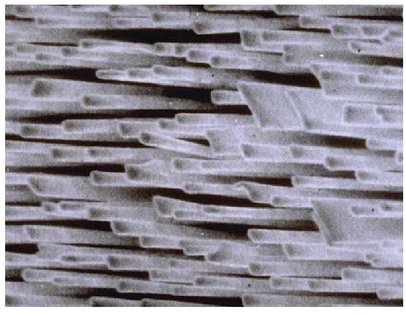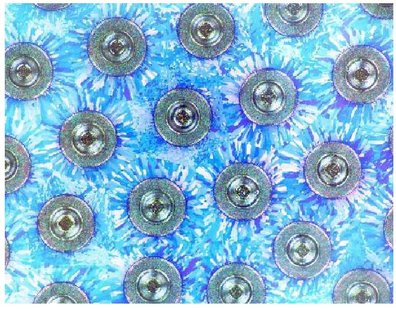Homogenization and micromechanics |
Homogenization and micromechanics are mathematical theories that allow one to "upscale" the microstructure of complex materials, in order to provide macroscopic or "homogenized" constitutive relations and material properties. This is very useful because frequently we are not interested in the variation of stress, displacement, velocity, etc. over short lengthscales such as a micro or nanometre if the entire system is of the order of say a meter. A good example is the application of such theories to composite media, which are made from distinct materials (often known as phases), combined in such a way as to optimize some physical property such as Youngs modulus, bulk modulus, thermal conductivity, viscosity, etc. Furthermore the composite may often exhibit certain behaviour, not exhibited by the phases from which it is comprised, such as induced anisotropy. This is particularly important in fibre reinforced composites and laminated plates. Here are two pictures of the microstructure of some composite media: the first is a Copper Cobalt composite and the second is a silicon carbide-titanium alloy.
Experimental studies prove extremely expensive and it is therefore of great interest to model these materials mathematically. The subject areas devoted to such studies are those of homogenization and micromechanics. Over the last few decades, these subjects have grown immensely, leading to a much greater understanding of materials that are used extensively in engineering applications including the automotive, aerospace and energy sectors. More recently, homogenization has been applied in order to study and model the effective constitutive behaviour of biological tissues such as bone, tendon and skin.
Within the Waves group we have developed a number of new techniques of homogenization and applied these and other methods to a number of materials. These can be classified as dynamic (using wave techniques) and static methods. Below we refer to publications associated with statics methods, those associated with dynamic techniques can be see on the metamaterials page under the theme of multiple scattering.
Within the Waves group we have developed a number of new techniques of homogenization and applied these and other methods to a number of materials. These can be classified as dynamic (using wave techniques) and static methods. Below we refer to publications associated with statics methods, those associated with dynamic techniques can be see on the metamaterials page under the theme of multiple scattering.
- G. Rus, J. Melchor, N. Bochud, L. Peralta and W.J. Parnell (2019) (open access)
"Damage prediction via nonlinear ultrasound: a micromechanical approach"
Ultrasonics 93, 145-155. - W.D. Rowley, W.J. Parnell, I.D. Abrahams, S.R. Voisey, J. Lamb and N. Etaix, N. (2018) (open access)
"Deepening subwavelength acoustic resonance via metamaterials with universal broadband elliptical microstructure"
Applied Physics Letters 112, 251902 - C. Calvo-Jurado and W.J. Parnell, (2018)
"Induced fields in isolated elliptical inhomogeneities due to imposed polynomial fields at infinity"
Int. J. Computer Math. - Geer, S., Berger, J.R., Parnell, W.J. and Mustoe, G.G.W. (2017)
"A Comparison of Discrete Element and Micromechanical Methods for Determining the Effective Elastic Properties of Geomaterials"
Computers and Geotechnics. 87, 1-9 - Calvo-Jurado, C. and Parnell, W.J. (2017) (open access)
" The influence of two-point statistics on the Hashin-Shtrikman bounds for three-phase composites"
J. Comp. Applied Math. 318, 354-365. - D. Joyce, W.J. Parnell, R.C. Assier and I.D. Abrahams (2017) (open access)
Proc. Roy. Soc. A 473:20170080
- Joyce, D. and Parnell, W.J. (2017)
"The Newtonian potential inhomogeneity problem: non-uniform eigenstrains in cylinders of non-uniform cross section"
J. Eng. Mathematics (50 years special issue) - Parnell, W.J. (2016) (open access)
"The Eshelby, Hill, moment and concentration tensors for ellipsoidal inhomogeneities in the Newtonian potential problem and linear elastostatics"
J. Elast. 1-64 - Calvo-Jurado, C., & Parnell, W. J. (2016)
"The influence of two-point statistics on the Hashin–Shtrikman bounds for three phase composites"
J. Comp. Appl. Mathematics 0377-0427 - Parnell, W.J. and Calvo-Jurado, C. (2015)
"On the construction of the Hashin-Shtrikman bounds for transversely isotropic two-phase linear elastic fibre reinforced composites"
J. Eng. Mathematics 95, 295-323 - Calvo-Jurado, C. and Parnell, W.J. (2015)
"The Hashin-Shtrikman bounds on the effective thermal conductivity of a transversely isotropic two-phase composite"
J. Math. Chemistry 53, 828-843
- Williams, T.D. and Parnell, W.J. (2014) (open access)
"Effective antiplane elastic properties of an orthotropic solid weakened by a periodic distribution of cracks"
Quart. J. Mech. Appl. Math. 67, 311-342
- De Pascalis, R., Parnell, W.J. and Abrahams, I.D. (2013)
"Predicting the nonlinear pressure-volume curve of an elastic microsphere composite"
J. Mech. Physics Solids 61, 1106-1123 - Willoughby, N., Parnell, W.J., Hazel, A., Abrahams, I.D. (2012)
"Homogenization methods to approximate the effective response of random fibre-reinforced composites"
Int. J. Solids Structures 49, 1421–1433
- Parnell, W.J., Abrahams, I.D. and Brazier-Smith, P.R. (2010)
"Effective properties of a composite half-space: exploring the relationship between homogenization and multiple scattering theories"
Quart. J. Mech. Appl. Math. 63, 145-175
Our collaborators
|
From the UK
|
From around the world
|
|
|

